Related Research Articles

Ennomos alniaria, the canary-shouldered thorn, is a moth of the family Geometridae. The species was first described by Carl Linnaeus in his 1758 10th edition of Systema Naturae. It can be found in Europe in a wide variety of biotopes where there are deciduous trees, perhaps mostly in deciduous forests and gardens.

Freyer's pug is a moth of the family Geometridae. The species can be found in Europe, east to the Urals, the Russian Far East, Kazakhstan and China. It is also found in North America.
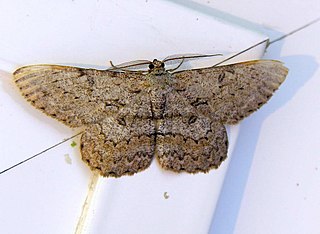
Hypomecis punctinalis, the pale oak beauty, is a moth of the family Geometridae. The species was first described by Giovanni Antonio Scopoli in his 1763 Entomologia Carniolica. The species can be found in central and southern Europe, Asia Minor, Transcaucasia, Russia, the Russian Far East, Japan, Korea, Ussuri and western China.
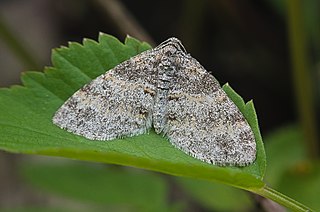
Lobophora halterata, the seraphim, is a moth of the family Geometridae. It was first described by Johann Siegfried Hufnagel in 1767. The species can be found in central and northern Europe and a few localities in southern Europe, Siberia, Amur, Primorye, Sakhalin and Japan.

Parascotia fuliginaria, the waved black, is a species of moth of the family Erebidae. It is natively found in Europe as far east as the Ural Mountains, in Armenia and Asia Minor and is an introduced species in North America.

Rhizedra lutosa, the large wainscot or Isle of Wight wainscot, is a species of moth of the family Noctuidae. It is native to the Palearctic realm. It has been introduced into eastern North America and is spreading.

Cleorodes is a monotypic moth genus in the family Geometridae described by Warren in 1894. Its single species, Cleorodes lichenaria, the Brussels lace, was first described by Johann Siegfried Hufnagel in 1767.
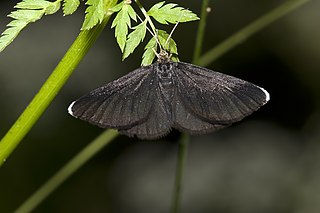
Odezia is a monotypic moth genus in the family Geometridae erected by Jean Baptiste Boisduval in 1840. Its only species, Odezia atrata, the chimney sweeper, was first described by Carl Linnaeus in his 1758 10th edition of Systema Naturae. It is found in the Palearctic.
Muschampia proto, the sage skipper, is a butterfly of the family Hesperiidae. It is found in Morocco, Algeria, the Iberian Peninsula, southern France, Italy, Sicily, Greece and in North Macedonia.
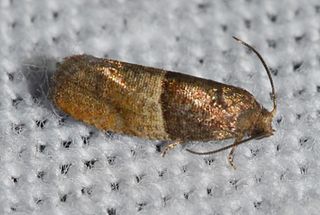
Larisa is a genus of moths belonging to the subfamily Olethreutinae of the family Tortricidae. It contains only one species, Larisa subsolana, which is found in North America, where it has been recorded from Alabama, Florida, Georgia, Illinois, Indiana, Kentucky, Maine, Maryland, Massachusetts, Minnesota, Mississippi, Missouri, New York, Ohio, Oklahoma, Ontario, Quebec, South Carolina, Tennessee, Texas, Virginia, and West Virginia.
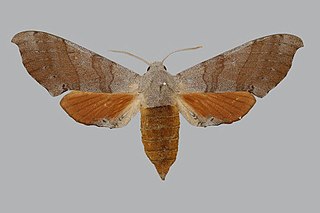
Polyptychus coryndoni is a moth of the family Sphingidae. It is known from Brachystegia woodland from Zimbabwe to Malawi, Zambia, the Democratic Republic of the Congo and Tanzania. It has also been recorded from northern Nigeria.
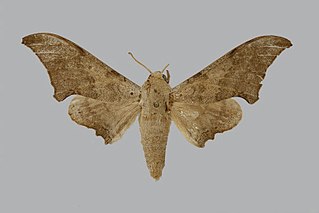
Falcatula cymatodes is a moth of the family Sphingidae. It is known from lowland forests in Ivory Coast, Ghana, Nigeria, Cameroon, Gabon, Uganda and the Central African Republic.
Temnora griseata is a moth of the family Sphingidae. It is known from forests from Nigeria to southern Congo, southern Tanzania and Malawi.
Jordanita volgensis is a moth of the family Zygaenidae. It is known from eastern Ukraine, southern Russia, Transcaucasia, Turkey and Syria.

Undulopsychopsis is an extinct genus of lacewing in the silky lacewing family Psychopsidae. The genus is solely known from a Cretaceous fossil found in China. Currently the genus is composed of a single species, Undulopsychopsis alexi.
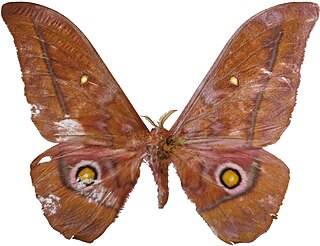
Nudaurelia xanthomma is a moth of the family Saturniidae. It is known from Cameroon, Ghana and Sierra Leone.

Nudaurelia cytherea, the pine tree emperor moth or Christmas caterpillar due to its festive colouration, is a southern African member of the family Saturniidae. The family has large edible caterpillars which are an important source of protein for the Bantu peoples of southern Africa. The genus Nudaurelia is closely related to Gonimbrasia and Imbrasia. The species was first described by Johan Christian Fabricius in 1775.
Caryocolum cassella is a moth of the family Gelechiidae. It is found in the France, Germany, Austria, Switzerland, Denmark, Scandinavia, Poland, the Czech Republic, Slovakia, Romania, Estonia, Lithuania, Ukraine, Belarus and Russia. It is also found in North America, where it has been recorded from Alberta, Saskatchewan, California and Nevada. A record from Hokkaido, Japan might also refer to this species.
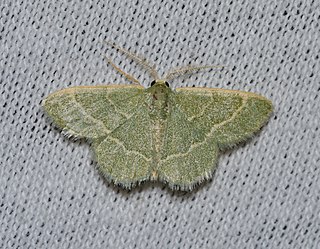
Chlorochlamys phyllinaria, the thin-lined chlorochlamys moth, is a moth of the family Geometridae. It is found in North America, where it has been recorded from Georgia to California, northward in the central states to Nebraska.

Emplastus is an extinct morphogenus of ants in the subfamily Dolichoderinae, known from fossils found in Asia and Europe. The genus contains twelve species described from sites in England, Eastern Europe and Far Eastern Russia.
References
- ↑ afromoths
- ↑ (in German) Weymer, G. W. 1909. Exotische Lepidopteren. - Deutsche entomologische Zeitschrift, Iris 22:1–35 - on page 6-7